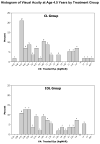Comparison of contact lens and intraocular lens correction of monocular aphakia during infancy: a randomized clinical trial of HOTV optotype acuity at age 4.5 years and clinical findings at age 5 years
- PMID: 24604348
- PMCID: PMC4138810
- DOI: 10.1001/jamaophthalmol.2014.531
Comparison of contact lens and intraocular lens correction of monocular aphakia during infancy: a randomized clinical trial of HOTV optotype acuity at age 4.5 years and clinical findings at age 5 years
Abstract
Importance: The efficacy and safety of primary intraocular lens (IOL) implantation during early infancy is unknown.
Objective: To compare the visual outcomes of patients optically corrected with contact lenses vs IOLs following unilateral cataract surgery during early infancy.
Design, setting, and participants: The Infant Aphakia Treatment Study is a randomized clinical trial with 5 years of follow-up that involved 114 infants with unilateral congenital cataracts at 12 sites. A traveling examiner assessed visual acuity at age 4.5 years.
Interventions: Cataract surgery with or without primary IOL implantation. Contact lenses were used to correct aphakia in patients who did not receive IOLs. Treatment was determined through random assignment.
Main outcomes and measures: HOTV optotype visual acuity at 4.5 years of age.
Results: The median logMAR visual acuity was not significantly different between the treated eyes in the 2 treatment groups (both, 0.90 [20/159]; P = .54). About 50% of treated eyes in both groups had visual acuity less than or equal to 20/200. Significantly more patients in the IOL group had at least 1 adverse event after cataract surgery (contact lens, 56%; IOL, 81%; P = .02). The most common adverse events in the IOL group were lens reproliferation into the visual axis, pupillary membranes, and corectopia. Glaucoma/glaucoma suspect occurred in 35% of treated eyes in the contact lens group vs 28% of eyes in the IOL group (P = .55). Since the initial cataract surgery, significantly more patients in the IOL group have had at least 1 additional intraocular surgery (contact lens, 21%; IOL, 72%; P < .001).
Conclusions and relevance: There was no significant difference between the median visual acuity of operated eyes in children who underwent primary IOL implantation and those left aphakic. However, there were significantly more adverse events and additional intraoperative procedures in the IOL group. When operating on an infant younger than 7 months of age with a unilateral cataract, we recommend leaving the eye aphakic and focusing the eye with a contact lens. Primary IOL implantation should be reserved for those infants where, in the opinion of the surgeon, the cost and handling of a contact lens would be so burdensome as to result in significant periods of uncorrected aphakia.
Trial registration: clinicaltrials.gov Identifier: NCT00212134
Conflict of interest statement
Figures


Comment in
-
Treatment outcomes of monocular infantile cataract at 5-year follow-up: work in progress.JAMA Ophthalmol. 2014 Jun;132(6):683-4. doi: 10.1001/jamaophthalmol.2014.2155. JAMA Ophthalmol. 2014. PMID: 24921166 No abstract available.
-
Comments on infant aphakia treatment study 4.5-year results.JAMA Ophthalmol. 2014 Dec;132(12):1491-2. doi: 10.1001/jamaophthalmol.2014.3532. JAMA Ophthalmol. 2014. PMID: 25256136 No abstract available.
-
In reply.JAMA Ophthalmol. 2014 Dec;132(12):1492-3. doi: 10.1001/jamaophthalmol.2014.3542. JAMA Ophthalmol. 2014. PMID: 25256439 Free PMC article. No abstract available.
References
-
- Wilson ME. Intraocular lens implantation: has it become the standard of care for children? Ophthalmology. 1996;103(11):1719–1720. - PubMed
-
- Wilson ME, Jr, Trivedi RH, Buckley EG, et al. ASCRS white paper. Hydrophobic acrylic intraocular lenses in children. J Cataract Refract Surg. 2007;33(11):1966–1973. - PubMed
-
- Bowman RJ, Kabiru J, Negretti G, Wood ML. Outcomes of bilateral cataract surgery in Tanzanian children. Ophthalmology. 2007;114(12):2287–2292. - PubMed
-
- Trivedi RH, Wilson ME, Vasavada AR, Shah SK, Vasavada V, Vasavada VA. Visual axis opacification after cataract surgery and hydrophobic acrylic intraocular lens implantation in the first year of life. J Cataract Refract Surg. 2011;37(1):83–87. - PubMed
-
- Ventura MC, Ventura BV, Ventura CV, Ventura LO, Nose W. Congenital cataract surgery with intracameral triamcinolone: pre- and postoperative central corneal thickness and intraocular pressure. J AAPOS. 2012;16(5):441–444. - PubMed
Publication types
MeSH terms
Supplementary concepts
Associated data
Grants and funding
LinkOut - more resources
Full Text Sources
Other Literature Sources
Medical

